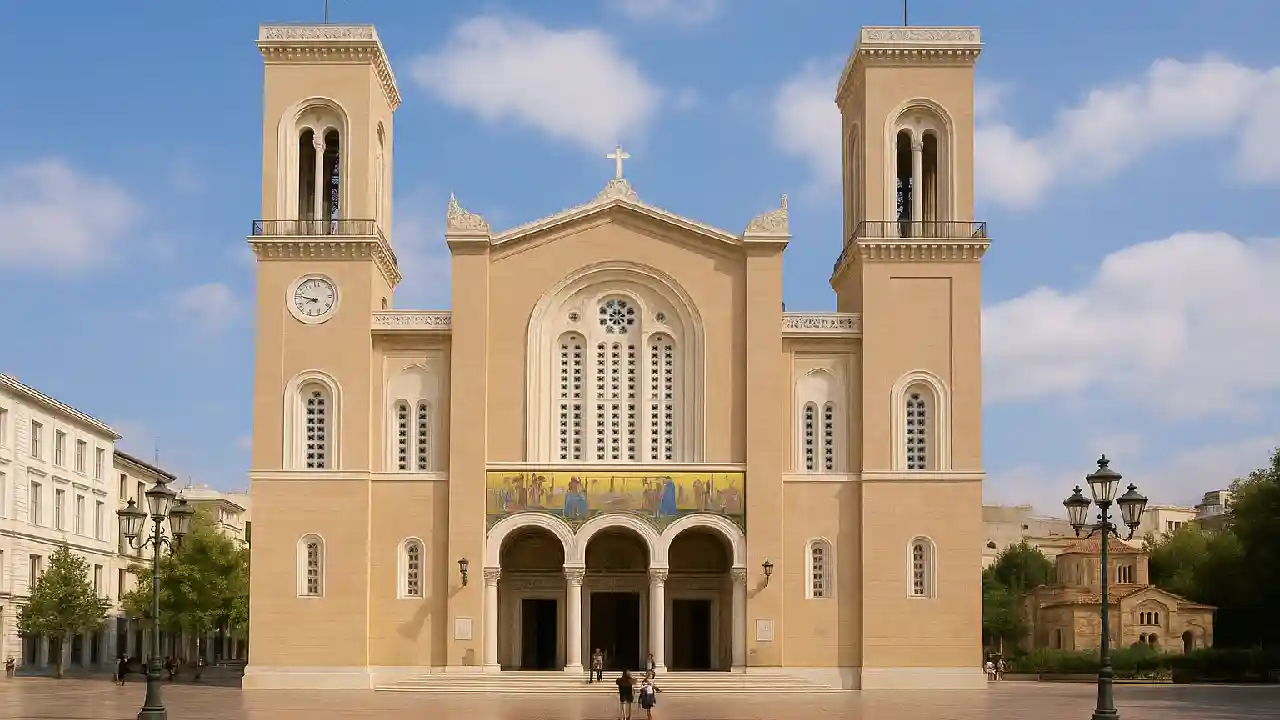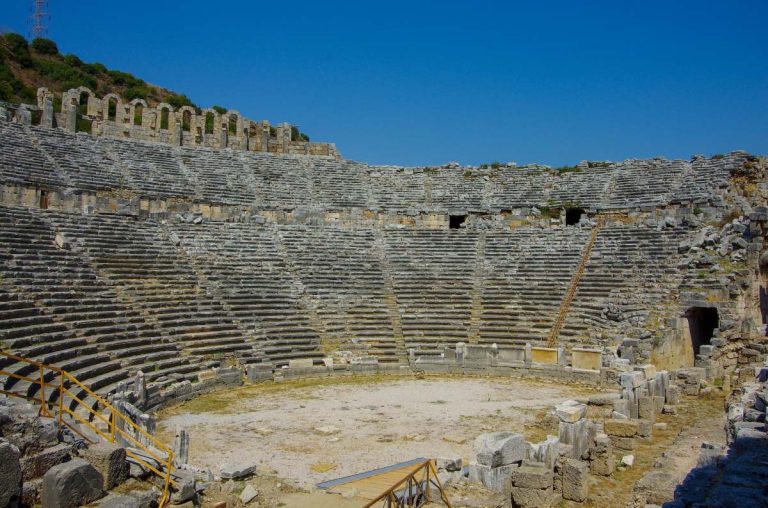Metropolitan Cathedral of Athens
Introduction
Nestled in the vibrant center of the Greek capital, the Metropolitan Cathedral of Athens, officially known as the Holy Metropolitan Church of the Annunciation to the Virgin Mary, stands as one of the most significant religious and historical landmarks in the city. Often simply called the Cathedral of Athens or the Metropolitan Church of Athens, this grand structure is the seat of the Archbishop of Athens and all Greece. With its elegant architecture, spiritual ambiance, and rich history, it is a masterpiece that represents both faith and national pride.
Historical Background of the Metropolitan Cathedral of Athens
The Metropolitan Cathedral of Athens was founded in 1842, shortly after Greece gained independence from Ottoman rule. King Otto of Greece laid the foundation stone on Christmas Day that year, marking the beginning of what would become the most important church in modern Greek Orthodoxy.
The cathedral took nearly two decades to complete, finally consecrated in 1862. During its construction, materials from over seventy demolished churches were used — a symbolic gesture representing the rebirth of the Greek nation and the unity of faith across the country.
Architectural Grandeur of the Metropolitan Church of Athens
The Metropolitan Church Athens reflects a stunning blend of Byzantine and neo-classical architectural styles. Its massive stone walls, high ceilings, and ornate decorations make it a masterpiece of 19th-century Greek architecture.
The cathedral measures around 40 meters long and 20 meters wide, crowned with three domes and two impressive bell towers. Inside, visitors are greeted by exquisite marble columns, intricate mosaics, and icons depicting scenes from the life of the Virgin Mary and Christ.
Design Elements and Artistic Details
Every inch of the Metropolitan Cathedral of Athens tells a story. The frescoes are painted by renowned Greek artists, while the iconostasis (icon screen) separates the nave from the sanctuary, richly adorned with gold leaf and religious imagery. The blend of traditional Orthodox design with neoclassical influences makes the church a unique artistic marvel in Athens.
Religious Importance and Cultural Role
The Holy Metropolitan Church of the Annunciation to the Virgin Mary holds profound significance for the Greek Orthodox community. It is the site of major religious ceremonies, national events, and state funerals. Over the years, it has hosted coronations, weddings, and the funerals of important Greek leaders and cultural figures.
For Greek citizens, it symbolizes both their spiritual devotion and national identity — a sanctuary where faith and patriotism unite.
The Annunciation to the Virgin Mary – A Sacred Dedication
The cathedral is dedicated to the Annunciation to the Virgin Mary, a pivotal event in Christian belief where the Archangel Gabriel announces to Mary that she will give birth to Jesus Christ. This dedication gives the church its official name and spiritual essence, making it one of the holiest sites in Athens.
Exploring the Interior of the Cathedral of Athens
Stepping inside the Cathedral of Athens is an awe-inspiring experience. The light filtering through stained-glass windows illuminates the sacred icons and frescoes, creating a serene atmosphere. The marble floors, elegant chandeliers, and intricate carvings showcase the craftsmanship of 19th-century artisans.
The Tombs of Saints and National Figures
Within the Metropolitan Church of Athens, two tombs stand as poignant reminders of faith and sacrifice. One belongs to Saint Philothei, a revered Athenian martyr who dedicated her life to helping enslaved women during Ottoman rule. The other tomb houses the remains of Patriarch Gregory V, martyred during the Greek War of Independence. Their presence adds historical and spiritual depth to the church’s legacy.
Location and Surroundings
The Metropolitan Cathedral of Athens is located in Mitropoleos Square, a bustling area between Syntagma and Monastiraki. The square itself is surrounded by cafés, souvenir shops, and narrow alleys leading to historic neighborhoods like Plaka and Anafiotika. Just beside the cathedral lies the Little Metropolis, a small 12th-century Byzantine church dedicated to St. Eleftherios — a charming contrast to the grand cathedral.
Visiting the Metropolitan Church Athens
The Metropolitan Church Athens welcomes visitors daily, offering both spiritual solace and cultural enrichment. Entry is free, though visitors are expected to dress modestly and maintain a respectful demeanor.
Photography is permitted, but silence is encouraged during prayer hours. Sunday masses are especially moving, accompanied by Byzantine chants that echo through the cathedral’s vast interior.
Best Time to Visit
The ideal time to visit the Cathedral of Athens is during major religious festivals such as Easter or the Feast of the Annunciation (March 25th). During these times, the cathedral becomes a hub of activity, with processions, hymns, and beautifully decorated icons filling the sacred space.
Symbolism and Meaning Behind the Architecture
The cathedral’s twin bell towers represent the unity of faith and nation. The central dome, adorned with frescoes of Christ Pantocrator, symbolizes divine watchfulness over Athens. Every architectural element — from the arches to the altar — reflects the harmony between spirituality and artistry.
The Metropolitan Cathedral’s Role in Modern Athens
Today, the Metropolitan Cathedral of Athens serves not only as a religious center but also as a cultural and social hub. It hosts concerts, interfaith dialogues, and national commemorations. Its bells ring during both joyful and solemn occasions, reminding Athenians of their shared history and values.
Preservation and Restoration Efforts
Over time, the Metropolitan Church Athens has faced natural wear and earthquake damage. Restoration projects have been undertaken to preserve its structural integrity and artistic treasures. These efforts, supported by both the Greek government and the Church, ensure that future generations can continue to admire this architectural masterpiece.
A Spiritual Landmark for Tourists
For visitors exploring Athens, the Metropolitan Cathedral offers a peaceful retreat from the city’s bustling streets. It stands as a testament to Greece’s enduring faith and artistry, a must-visit site that connects the ancient with the modern.
Nearby Attractions
While visiting the Cathedral of Athens, travelers can explore nearby landmarks such as:
- Syntagma Square – the political and social heart of Athens
- Plaka District – a charming area filled with shops and tavernas
- The Acropolis – the crown jewel of Greek heritage
- The Little Metropolis – a Byzantine gem beside the main cathedral
Cultural Events and National Ceremonies
The Metropolitan Church of Athens is also the chosen venue for national ceremonies, including memorial services for fallen heroes and celebrations of independence. Its steps have witnessed historical moments, from royal weddings to presidential inaugurations.
Spiritual Experience for the Faithful
Attending a liturgy at the Holy Metropolitan Church of the Annunciation to the Virgin Mary is an unforgettable experience. The harmony of the choir, the scent of incense, and the glow of candlelight create a deeply spiritual atmosphere that resonates with believers and visitors alike.
Impact on Greek Art and Identity
The Cathedral of Athens has inspired countless artists, poets, and architects. It stands as a living monument to Greek resilience, blending art, faith, and history in perfect harmony. Its construction symbolized a new chapter for Greece — one of independence, unity, and divine guidance.
FAQs
What is the Metropolitan Cathedral of Athens known for?
It is known as the main Greek Orthodox church of Athens and the seat of the Archbishop, symbolizing faith and national unity.
When was the Cathedral of Athens built?
Construction began in 1842 and was completed in 1862, taking twenty years to finish.
What is the official name of the Metropolitan Cathedral of Athens?
Its full name is the Holy Metropolitan Church of the Annunciation to the Virgin Mary.
Where is the Metropolitan Church Athens located?
It is located in Mitropoleos Square, near Syntagma, in the center of Athens.
Can tourists visit the Metropolitan Cathedral of Athens?
Yes, it is open daily to visitors, and entry is free. Modest attire and quiet behavior are encouraged.
What are the nearby attractions to the Cathedral of Athens?
Nearby attractions include the Little Metropolis, Syntagma Square, Plaka, and the Acropolis.
Conclusion
The Metropolitan Cathedral of Athens is not just a religious monument but a living symbol of Greece’s faith, culture, and independence. Its graceful architecture, rich history, and enduring spiritual presence make it a timeless landmark. Whether you visit to pray, admire art, or explore history, the Holy Metropolitan Church of the Annunciation to the Virgin Mary offers an experience that touches the heart and soul of every visitor.







